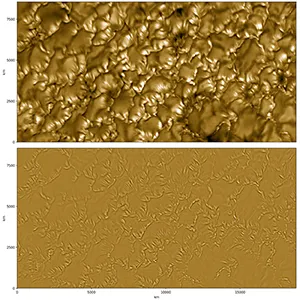
Sharpest-ever images of the Sun's surface reveal stripes that resemble silk threads
The sun never sits still, yet until recently our best snapshots blurred its fine threads. Now an image set from the Daniel K. Inouye Solar Telescope on Haleakalā resolves details just 20 kilometers wide, letting researchers watch bright and dark stripes move across the solar surface.
“We investigate the fine-scale structure of the solar surface for the first time with an unprecedented spatial resolution of just about 20 kilometers,” said Dr. David Kuridze, National Solar Observatory.
These tiny stripes, known as photospheric striations, measure less than the length of Manhattan.
Magnetic stripes on the solar surface
The facility uses a 4-meter mirror and a Visible Broadband Imager tuned to the G-band, a slice of blue light that highlights magnetic hotspots.
Two-second exposures stitched into mosaics capture the Sun’s boiling photosphere in scenes spanning 45 arcseconds.
Across each convection cell, hot plasma rises in the center, then cools and sinks at the edges. Along those edges the images reveal parallel bright and dark striations only 12 miles long and a few hundred feet wide.
The darkest lines sit where the magnetic field weakens, absorbing light and shading the view. Brighter lines outline regions where the field strengthens, allowing the lower layers of hotter gas to shine through.
In the sharpest frames, individual striations appear and vanish within a minute, hinting that the underlying magnetic pattern shifts as fast as weather on Earth. That fleeting behavior may help scientists test how turbulence lifts energy toward the corona.
Granules and curtains
Solar granules are cell-like tops about 600 miles across. Each one lasts only a few minutes before collapsing and yielding to a fresh granule.
Striations sit on the granule walls and form when sheets of magnetic flux tubes bend under the flow. The curtain description arises from the way the field drapes across the wall, sifting light in alternating bands.
Simulations using radiation-magnetohydrodynamic codes reproduce the same patterns once they include field variations of roughly 100 gauss. That agreement tells researchers they are finally seeing physics that once hid below the resolution line.
Because the field leans sideways, the lines run almost parallel to the solar limb in images taken away from disk center. Closer to disk center they fade, confirming that viewing geometry shapes what we see.
Why these solar stripes matter
Space-weather forecasts depend on knowing where magnetic energy builds up. Large flares usually start when twisted fields snap and reconnect.
“Magnetism is a fundamental phenomenon in the universe, and similar magnetically induced stripes have also been observed in more distant astrophysical objects,” commented Dr. Han Uitenbroek. Tiny striations may act like stress gauges, exposing subtle twists long before a flare blooms.
If the same physics repeats in stellar nurseries or planet-forming disks, measuring it on the Sun provides a local testbed. The data can sharpen star models that feed exoplanet climate codes.
Engineers also keep watch because a strong storm can harm satellites and knock out power lines on Earth. A clearer trigger could stretch warning times from hours to days.
“Wilson depression” explained
When a magnetic flux tube rises, the gas inside becomes thinner, so light escapes from deeper, hotter layers. That drop in the visible-surface height is called the Wilson depression.
In the new images, each bright stripe marks a spot where the Wilson depression digs up to 30 kilometers below its surroundings, while a neighboring dark stripe sits higher and cooler.
These height steps, though smaller than Mount Everest’s summit, sculpt the Sun’s textured look.

Earlier telescopes blurred those steps into single bright faculae. The recent Inouye view shows a magnetic staircase instead.
Knowing the depth lets modelers set realistic boundary conditions in helioseismology codes that trace waves beneath sunspots. That, in turn, refines estimates of how energy climbs from the convection zone to the outer atmosphere.
Space weather stakes
During Solar Cycle 25 the Sun has already launched multiple coronal mass ejections that merged en route to Earth. Stacked eruptions of that kind can supercharge geomagnetic storms.
Fine-scale magnetic stripes could point to the places where those ejections will erupt. Spotting them early may improve flight reroutes and satellite drag forecasts.
The data also help space agencies protect Artemis lunar hardware and planned Mars missions. Even a brief particle surge can upset delicate electronics.
Rapid-fire imaging now under way will map how stripes evolve through an entire solar rotation, linking them to flare statistics. That project could reveal whether a threshold in stripe density marks an impending eruption.
Solar physics and magnetic stripes
The Inouye team is upgrading its Visible Tunable Filter to capture the same region ten times faster. Faster cadence will freeze the photospheric turbulence in time-lapse detail.
Researchers also plan multi-wavelength campaigns linking Inouye images with Parker Solar Probe plasma data, bridging photosphere to heliosphere. That link will test whether small stripes seed the giant switchbacks the probe registers.
On the modeling side, new simulations down to 4-kilometer grids will hunt for instabilities such as the flute mode that could carve magnetic curtains. The work may explain why stripes sometimes split or merge.
Once those answers land, the next leap may involve an even larger infrared telescope now on the drawing board, one that peers deeper into sunspot roots. Bigger mirrors continue to shrink the gap between theory and observation.
The study is published in The Astrophysical Journal Letters.
—–
Like what you read? Subscribe to our newsletter for engaging articles, exclusive content, and the latest updates.
Check us out on EarthSnap, a free app brought to you by Eric Ralls and Earth.com.
—–













